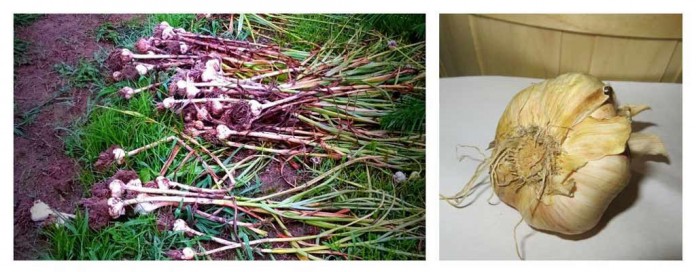Garlic is one of the oldest known foods. It has been used for culinary and medicinal purposes for thousands of years. Although grocery stores typically stock a single standard garlic, hundreds of garlic varieties with unique flavors and exotic origins are available to garlic gardeners.
Growing garlic is easy. Garlic planted in fall and overwintered is ready to harvest by mid to late summer.
Purchase seed garlic now to ensure best selection. Most producers take preorders in summer and ship for fall planting. Locally grown garlic seed is better adapted to regional climate conditions and pests, and typically produces a better bulb.
Garlic 101
Garlic is categorized as hardneck or softneck.
Hardneck garlic has a strong center stem. It does well overwintering in cold climates. Hardneck garlic produces smaller bulbs than softneck. Cloves are easy to peel. Asiatic, Creole, Marbled Purple, Porcelain, Rocambole and Turban garlics belong to the hardneck group.
Softneck garlic has a soft stem that flops over when it is ready to harvest. Traditional folksy garlic braids are made with softneck varieties. Softnecks are abundant producers of big bulbs with many cloves. Artichoke and Silverskin garlics belong to the softneck group.
10 steps to overwinter garlic
- In fall, prepared your soil for planting. I apply compost heavily and make sure soil is well-drained and aerated.
- Start with well-developed, high-quality garlic bulbs. Separate cloves.
- Plant each clove pointed end up, 2-4 inches deep, 5-6 inches apart. Sow in rows 18 inches apart.
- Cover with soil.
- Water well for 3-4 days.
- Top with 6 inches of straw mulch.
- Allow garlic to overwinter.
- When snow melts in spring, add an additional 4-6 inches of straw mulch to suppress spring weeds.
- By early summer garlic will form buds. Break the steam to redirect that energy to bulb formation.
- In mid to late summer the tops of stalks will start to turn brown, signaling it’s time to harvest.
How to harvest garlic
- Dig cloves carefully to avoid scuffing bulbs.
- Remove loose dirt by brushing or wash away with a high pressure hose. Be careful not to damage garlic.
- Hang in a well ventilated area for 4 weeks to cure.
- Remove stems and store bulbs in airy, dry conditions until use.













An 80+ year old 5th generation farmer once told me to plant garlic in Southeast Ohio on October 5th every year. I asked him why he recommended that particular day, assuming it had something to do with day length or the position of the moon, and he replied, “I don’t know. That’s when we ALWAYS planted it.”
I think your friend is on to something! Perfect fall planting weather. I began planting my garlic today in south central Ohio.
I have searched all over my are for garlic to grow. I’ve been told repeatedly that it’s not available until Spring. Yet, every video and article I’ve seen about growing garlic says to plant in the fall. Can you clear up my obvious confusion? I live in North-Central Arkansas (Ozarks).
I just bought Garlic from a natural grocery store in produce section. The stems came up pretty quick and have been green all winter.
In Georgia can we plant our garlic as late as Thanksgiving? I’m a little behind this year because of a broken ankle.
The University of Georgia Extension is a great resource for your growing zone. It recommends planting garlic from late September through November. Thanksgiving may be a little on the later side, but it should be fine. You can find more information on growing garlic in Georgia here: https://extension.uga.edu/publications/detail.html?number=C854&title=Garlic%20Production%20for%20the%20Gardener#:~:text=Late%20September%20through%20November%20is,be%20well%20rooted%20by%20November.
We are having our frosty mornings now in northern Virginia. My garlic, which I planted in late September, already has green leaves. Should I clip them for the winter?
You can clip them and you might want to add a 4-6 inch layer of mulch to protect them while they overwinter. Leaves and straw work well. You can find more tips here — https://www.farmanddairy.com/top-stories/how-to-plant-garlic-cloves-in-the-fall/570663.html
I planted my garlic in grow bags about a month ago and they are up and out of the dirt…some are about 4-5″ tall already…winter/freeze is predicted in the next couple of weeks…should I cover the soil with straw? Will the already sprouted garlics greenery die off/freeze? Thanks
Well, I think a lot of folks are ending November with lots of sprouted garlic this year, as areas like Ohio had an unusually warm Fall, with several days hitting or approaching record highs. I cover my garlic bed with 3-4 inches of leaves, topped with enough loosely-shaken straw to keep the leaves from blowing away. It’s not too late to mulch now and you should do so. I believe that, ideally, mulch is applied before plants begin to sprout, so that if the plants DO sprout, the sprouts find their own way through through the mulch, standing upright. Appling mulch later and you risk bending the plants over from weight of the mulch.
What I have written comes from my experience growing garlic in raised beds. Perhaps someone who has used grow bags before can chip in.